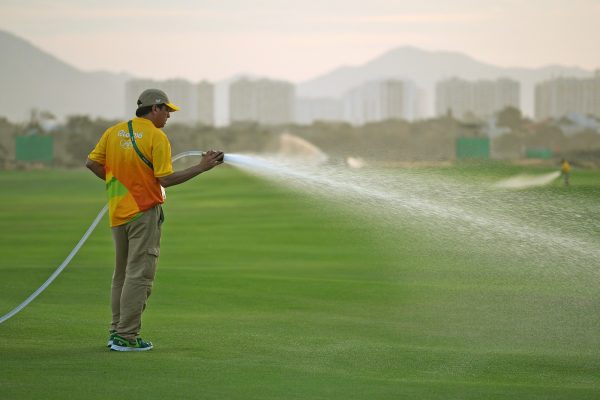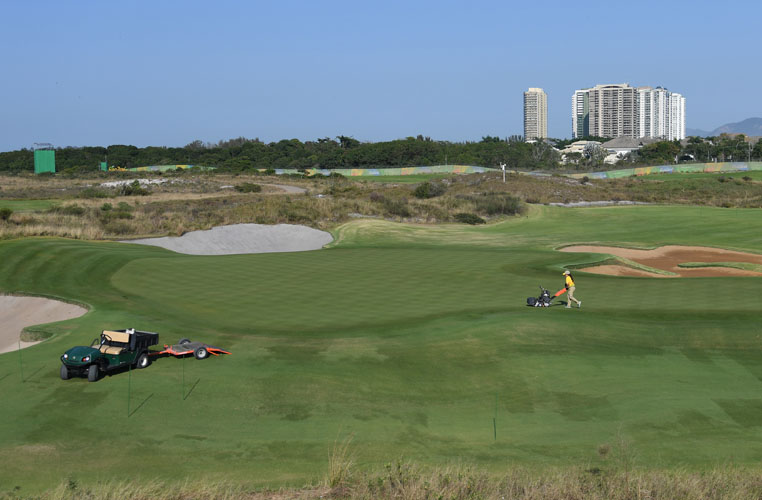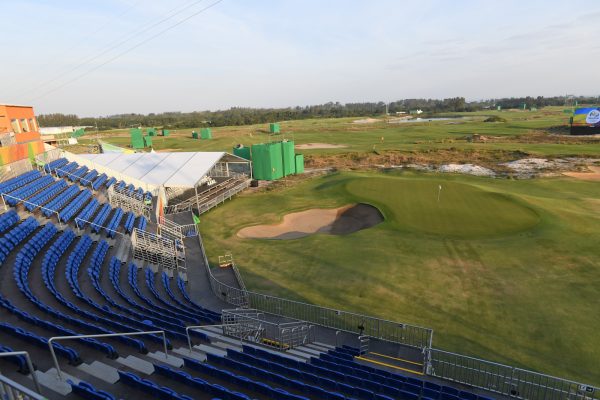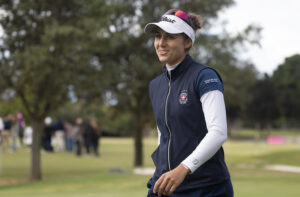Architect Gil Hanse takes you on a personal tour of Reserva de Marapendi, the Olympic Golf Course in Rio de Janeiro.
It has been a labour of love for the highly acclaimed golf course architect, who beat off competition from other high profile course designers to win the right to construct the country’s first new course in several generations.
Hanse overcame many challenges to build a course, along with co-designer and LPGA Tour Hall of Famer, Amy Alcott, which will provide a lasting legacy from a sustainability and environmental standpoint, and also from a golfing, social and educational one. After the Olympic Games, the complex will become Brazil’s first ‘pay and play’ facility.
Here, Gil leads you on a personal tour of the 18 holes over which the first Gold Medals since 1904 will be won and lost.

Olympic Golf Course
Barra da Tijuca, Rio De Janeiro, Brazil
Men – 11-14 August, 2016
Women – 17-20 August, 2016
Hole 1
| Par | Men (meters) | Men (yards) | Women (meters) | Women (yards) | |
| 5 | 552 | 604 | 490 | 536 |
This long par five will play predominantly down wind and should be reachable by the longer hitters in the field. The landing area is guarded by numerous bunkers and a gentle rise in the landscape, and the golfer who can get to the left side of the landing area will be rewarded with an unobstructed view for the second shot.
A dune that we found on site provides the visual and playable challenge for the second shot as it obscures the second landing area. However, there is plenty of room for the second shot beyond the dune. The green is a mirror image of the eighth hole at Augusta National, guarded on the right by large tightly mown mounds, with smaller mounds guarding the left and rear of the green. Depending on the hole location, the golfers will want to approach this green from either the far right or left sections of the fairway to gain the maximum advantage.
Hole 2
| Par | Men (meters) | Men (yards) | Women (meters) | Women (yards) | |
| 4 | 444 | 486 | 398 | 435 |
The back tee is located on the highest elevation on the property and from here the ocean can be viewed on the horizon. The view of the golf hole shows a dogleg left fairway that is guarded on the left by bunkers and some heavy vegetation. There is a drop-off in the fairway just beyond the bunkers, so the golfer who carries this line will be rewarded with an extra kick forward for the tee shot. The green sits with a large lake to its left and a wide expanse of short grass and mounds to the right of the green. The observant golfer can use these mounds to feed a ball towards the green if they get in trouble off the tee or if they have a long approach to the green. The golfers should be particularly wary of the hole locations near the water as the green slopes in that direction.
Hole 3
| Par | Men (meters) | Men (yards) | Women (meters) | Women (yards) | |
| 4 | 321 | 351 | 294 | 321 |
We hope that the setup in our design varies from day to day and this hole has a lot of flexibility in the yardage it can be played from. It is the most visually daunting tee shot on the course with water to be carried and then extending down the left side of the hole and to the rear of the green. Along the right side of the hole are sandy areas that are bordered by the indigenous vegetation on site. The green is one of the largest on the course, it is much wider than it is deep, and is guarded on the right by bunkers and to the rear by water and sand. With a myriad of opportunities for interesting hole locations, angles of attack will be important especially to the front left hole location that will appear to hover out over the water.
Hole 4
| Par | Men (meters) | Men (yards) | Women (meters) | Women (yards) | |
| 3 | 175 | 191 | 142 | 155 |
One of the most beautiful holes on the course, this mid length par three is set next to the open sand and scrub vegetation that provides the site with its most interesting landscapes. The hole plays relatively level over the length of the hole, however, the green is surrounded by sand and significant fall-offs to all sides. Once on the green, the real challenges begin as the undulating character of the green creates not only interesting pin positions, but also some interesting putts.
Hole 5
| Par | Men (meters) | Men (yards) | Women (meters) | Women (yards) | |
| 5 | 500 | 547 | 451 | 493 |
The shortest par five on the golf course should be reachable for most of the players in both fields (men and women). From the back tee the golfers will play out of a chute of native vegetation into the vast open expanse of the center portion of the course. The tee shot is guarded on the left by the large lake, and on the right by some exposed sand and native grasses. From the fairway, the second shot is played to an uphill green that sits on a sand ridge. Cut into the face of the green are two of the deepest bunkers on the course, and the miss to the left of the green will find a sharp drop off in tightly mown turf. The green is a small target with a mound to the right of the green that golfers can use to feed balls down on to the putting surface.
Hole 6
| Par | Men (meters) | Men (yards) | Women (meters) | Women (yards) | |
| 3 | 179 | 196 | 162 | 177 |
One of the more distinctive holes on the course, this par three can be played from two conspicuously different angles. We must admit that we like the hole better from the left as it plays semi-blind over a dune ridge into a punchbowl type green. From this tee the golfer can only see the far right/forward section of the green and the use of the downslope off the ridge into the green can be very helpful. From the right hand tee angle, which is played from directly behind the fifth green, the golfer can see most of the green with the exception of the far right side of the green. From this angle, the dune ridge is to the left of the green and can be used as a sideboard into the hole. The green is large and fairly flat, but all of the big contours surrounding the green will make the breaks even more deceptive.
Hole 7
| Par | Men (meters) | Men (yards) | Women (meters) | Women (yards) | |
| 4 | 451 | 493 | 374 | 409 |
Potentially the most difficult hole on the course, this long par four plays head-on into the prevailing wind. The tee shot needs to avoid deep fairway bunkering on the right side of the hole, and if these are navigated, the golfer will be up on a ridge with a good angle and great visibility into the hole. Golfers who play away from the bunkers will catch a strong side slope and be fed further left and down into a bowl. From this position the green is not completely visible, and the hole plays longer. The green is set on a rise, with a steep false front, a bunker guards the right side of the green and a tightly mown slope to the left of the green can be used to feed balls down on to the putting surface. The far right hole location on this green is hooked behind the bunker and will prove to be the toughest target on this challenging hole.
Hole 8
| Par | Men (meters) | Men (yards) | Women (meters) | Women (yards) | |
| 3 | 157 | 172 | 141 | 154 |
The next par three, one of three on the outward nine, plays from an elevated tee over a valley and back up to the green. The right side of the hole is protected by a diagonal line of bunkers that start in the approach and work their way along the entire right side for the hole. Just over these bunkers lies the approach which feeds strongly from right to left and can be used to feed balls on to this green. The right side of the green continues this sloping contour and will feed balls into a valley on the front left of the green, which is guarded by a large bunker. Most of the hole locations on this green will be along the back ridge which will require a well -played shot to get the ball all the way back there.

Hole 9
| Par | Men (meters) | Men (yards) | Women (meters) | Women (yards) | |
| 4 | 337 | 369 | 296 | 324 |
The front nine concludes with a short par four that, depending on setup, could be drivable during one of the rounds. The distinctive feature of this tee shot is the cashew tree/bush sitting on a dune that we found and decided to leave because of its unique character. This tree blocks the vision of the center of the fairway, however, bunkers to the left and right provide lines for the golfer to proceed. Like many of the holes on the course, angle of attack will be critical to success on the ninth hole, as it is fronted by two closely mown mounds. Approach shots played into the smallest green on the course, will find it will be difficult to hit and hold the green from the wrong angle, i.e., playing to the right side of the green will be best accomplished from the left side of the fairway, and vice versa. This is one of the holes on the course that we are most excited to see the best players take on and try to figure it out.
Hole 10
| Par | Men (meters) | Men (yards) | Women (meters) | Women (yards) | |
| 5 | 539 | 590 | 481 | 526 |
Same as the front nine, the outward nine starts with a par five hole to get the golfers out into the course. The tee shot on this hole is one of the most difficult on the course, with water down the left side of the hole and the prevailing wind coming from the left, which will ask the golfer to hold the ball into the wind and flirt with the water. To the right is native scrub and sand which will make getting home in two impossible if the tee shot is leaked to the right. The hole doglegs around the pond and the second shot that can carry the pond and find the left side of the fairway will be rewarded with a great angle into the long, but not very deep green. The right side (or direct line) to the green is guarded by sand and bunkers, and also defended by a poor angle into the narrowest part of the green. Once the green is found there are a series of levels and hollows that will make for interesting putting. Watch for the front left hole location, it is one of the most difficult to access.
Hole 11
| Par | Men (meters) | Men (yards) | Women (meters) | Women (yards) | |
| 4 | 446 | 488 | 384 | 420 |
Playing from the low lying terrain along the lagoon, this tee box is intentionally low so as to create a challenge to the depth perception of the player as they look out on the hole. A large bunker that is shared with the 12th hole is in the players face off the left side of the tee and a large sand dune with smaller sand rolls is the primary hazard guarding the corner of this dogleg left hole. There are miles of fairway out to the right. However, the further right the golfer goes off the tee, the more difficult the approach shot becomes. The bulk of the hole plays through the low centre section of the course, but the second shot is played up to a green that sits on the ridge running through the middle of the course. The green is defended by a deep bunker on the front right and a tightly mown hollow on the left. This green has a lot of slope from front to back and one of the most demanding hole locations on the entire course is the back right hole location over the bunker.

Hole 12
| Par | Men (meters) | Men (yards) | Women (meters) | Women (yards) | |
| 4 | 470 | 514 | 393 | 430 |
The toughest stretch of holes on the course starts with the 11th and is only amplified by the very difficult 12th hole. The longest par four on the course starts from a slightly elevated tee position playing back into the lower section of the course. Sand and scrub set up a diagonal carry down the right side of the hole and the left landing area is guarded by the large bunker between holes 11 and 12. Tee shots that can hug this bunker will find a slightly elevated section of the fairway which provides a better view of this low profile green.
From the right side of the fairway the view of the green is obstructed by a series of mounds and dunes that are well short of the green in the approach. The green is hemmed in on both sides and the second shot is a demanding one with a protected native area close to the right side of the green, and the lagoon well to the left. With all of this trouble around the green there was no need for additional hazards, just tightly mown turf surrounding the green. Befitting of its elevation, this green hugs the ground contours and slopes to the left. Getting out of here with a four should make every golfer proud of their accomplishment and ready to move on to the remaining two holes in this difficult four-hole stretch.
Hole 13
| Par | Men (meters) | Men (yards) | Women (meters) | Women (yards) | |
| 4 | 438 | 479 | 373 | 408 |
After a nice walk through the forest, the golfers will emerge on to the 13th tree and play a golf hole that looks unlike any other on the property. The 13th enters the section of the site where mature vegetation flanks both sides of the hole. On the inside corner of the dogleg right hole is the largest tree on the property, although golfers of Olympic calibre will play over the top of the tree if they are looking for the most aggressive line to the hole.
In the landing area, the right side is protected by the tree line and a meandering line of sand and scrub. The outside portion of the hole has some interesting ground contours that will provide interesting stances and lies for the golfers who do not challenge the right side of the hole. The approach to the green is wide open, defended only by smaller contours, and a steep false front on the green. To the right and to the back left are two bunkers that will challenge the wayward shots, otherwise the primary recovery challenge will be gauging the type of shot to be played to the various hole locations on this interesting green. The plateau green is the most undulating on the course, and as a team we decided that we had not created a hole yet where the primary defense for the second shot is the contouring of the green itself. This green took care of that concept and it will most likely prove to be the green that receives the most discussion as well as the most three putts on the course.
Hole 14
| Par | Men (meters) | Men (yards) | Women (meters) | Women (yards) | |
| 3 | 209 | 229 | 174 | 190 |
The longest par three on the golf course completes this run of tough golf holes. From a slightly elevated tee, the golfers will be faced with a lot of sand between them and the green. This hole is roughly modeled after the 16th hole at Royal Melbourne West, and it contains a nice diagonal run of bunkers along the right side of the hole. The green complex is slightly raised and there is a ridge at the front of the green that can be used to steer balls towards the right and around the bunkers. Short grass and a bunker back left provide the challenge for the golfer who wants to stay clear of the dramatic sand-scape along the right. Keep an eye out for the back right hole location, its combination of length and angle will prove to be a real test.
Hole 15
| Par | Men (meters) | Men (yards) | Women (meters) | Women (yards) | |
| 4 | 377 | 412 | 342 | 374 |
The turn for home starts literally a few steps off the 14th green as golfers move onto the 15th hole. The tee shot is played out of the wooded section of the property and heads back into the main body of the course. A diagonal carry over sand and a bunker in the foreground on the right, sets the stage for the decision making as it relates to the bunker in the centre of the fairway. From the tee the bunker appears to be on the right side of the hole, however, there is more room to the right than meets the eye.
At over 300 yards from the tee and with the prevailing wind blowing from the right and into the golfer, it will be interesting to see what options the golfers choose in trying to avoid this bunker which will definitely extract a one shot penalty for those who venture into it. The green is located on a ridge with a steep slope guarding its front and a very deep cluster of bunkers guarding the front left of the green. A bunker on top of the ridge guards the right side of the hole and completes the protection for this sloping green. The green features an appendage that stretches out to the left and it is on this arm of the green where the most difficult hole locations will appear.
Hole 16
| Par | Men (meters) | Men (yards) | Women (meters) | Women (yards) | |
| 4 | 277 | 303 | 241 | 264 |
If the 15th hole serves as the transition from the lower section of the course to the upper, the 16th hole is the introduction to the finishing run of holes where scoring opportunities will be plentiful for the golfers competing in Rio. This hole should be drivable for almost all of the competitors. However, it is a hole with plenty of options and some may decide that not giving it a go may be the best option for them. For those choosing to play the hole conservatively, the tee shot needs to navigate some of the largest fairway undulations on the property, as well as a cluster of bunkers down the right, and out of bounds lurking far to the left.
With the prevailing wind coming from the right, the correct shape for the tee shot will be important. The small hourglass shaped green will dictate that angles will be an important part of how the green is best assailed. With tightly mown mounds on the front right and front left of the green, golfers who get out of position to these pins will really struggle to get up and down for birdie. The back left of the green is defined by a sharp grass fall off to the left and rear of the green, which will make recovery efforts very delicate. The final hole location is back right and it has a deep bunker guarding it from any approach on the right side of the hole. We hope to see a wide dispersion of scores on this hole, however, if you walk off this green making a par four you will feel like you have given one back to the field.
Hole 17
| Par | Men (meters) | Men (yards) | Women (meters) | Women (yards) | |
| 3 | 122 | 133 | 110 | 120 |
The shortest par four (16th hole) on the golf course is followed by the shortest par three (17th hole). With a short iron in hand, the golfers will be playing back into the prevailing wind, and will be faced with a target that is not all that it appears to be. The eccentric shape of the green is not readily apparent from the tee, and while we would love to say that this was on purpose, it is just one of those things that developed in the field during construction. The green is guarded on the left by a series of bunkers, the furthest one cuts fiendishly into the green and creates a separation from upper right to lower left on the green.
The most difficult bunkers can be found to the right and back right of the green and a dune ridge will also provide a challenge to the shot that is fired well right. Over the back of the left hand arm of the green is a tightly mown chipping area that will require the most delicate of touches to get back in play from this area. Due to its short nature and location as the penultimate hole, we are hopeful that golfers will play aggressively on this little par three and that scoring will reflect this aggression. But this hole does have some teeth and it will bite back at the golfer who is even the slightest bit wayward in their concentration or precision.

Hole 18
| Par | Men (meters) | Men (yards) | Women (meters) | Women (yards) | |
| 5 | 522 | 571 | 465 | 509 |
The home hole is a mid-length par five that plays back into the prevailing wind. Depending on the strength of the wind, the hole will be reachable by all or parts of the field on any of the competition days. The tee shot plays over a native sand and scrub area to a heavily bunkered landing area, complicating matters is that the landing area is partially obscured by the topography in the area and the players will need to pick a line and trust it. Combining this mental focus with the potential pressures of winning an Olympic medal will only add to the concentration required on this shot. Once the fairway is found, the second shot will be played to an area that is pretty wide, however, in order to set up the next shot successfully the golfers will need to choose an angle for their strategy. Far left runs out into a sandy area, and far right is defended by bunkers.
For the golfer who is going for the green in two, there is an opening in the left approach that will feed a ball on to the green, this ground contour could be a great asset for the golfer who thinks their approach shot through. To the front right of the green, is a deep valley and steep rise to the green, reminiscent of the Valley of Sin on The Old Course in St Andrews. Playing a shot out of this area will require a skillful touch as the final green is small but has some of the most interesting contours on the entire course. The aggressive golfer who goes over the green will most likely find a deep bunker shot will be their recovery option. We are hopeful that the strategy and thought process built into this hole will be in evidence as players compete for Olympic Gold.
| Par | Men (meters) | Men (yards) | Women (meters) | Women (yards) | |
| TOTAL | 71 | 6516 | 7128 | 5711 | 6245 |



















